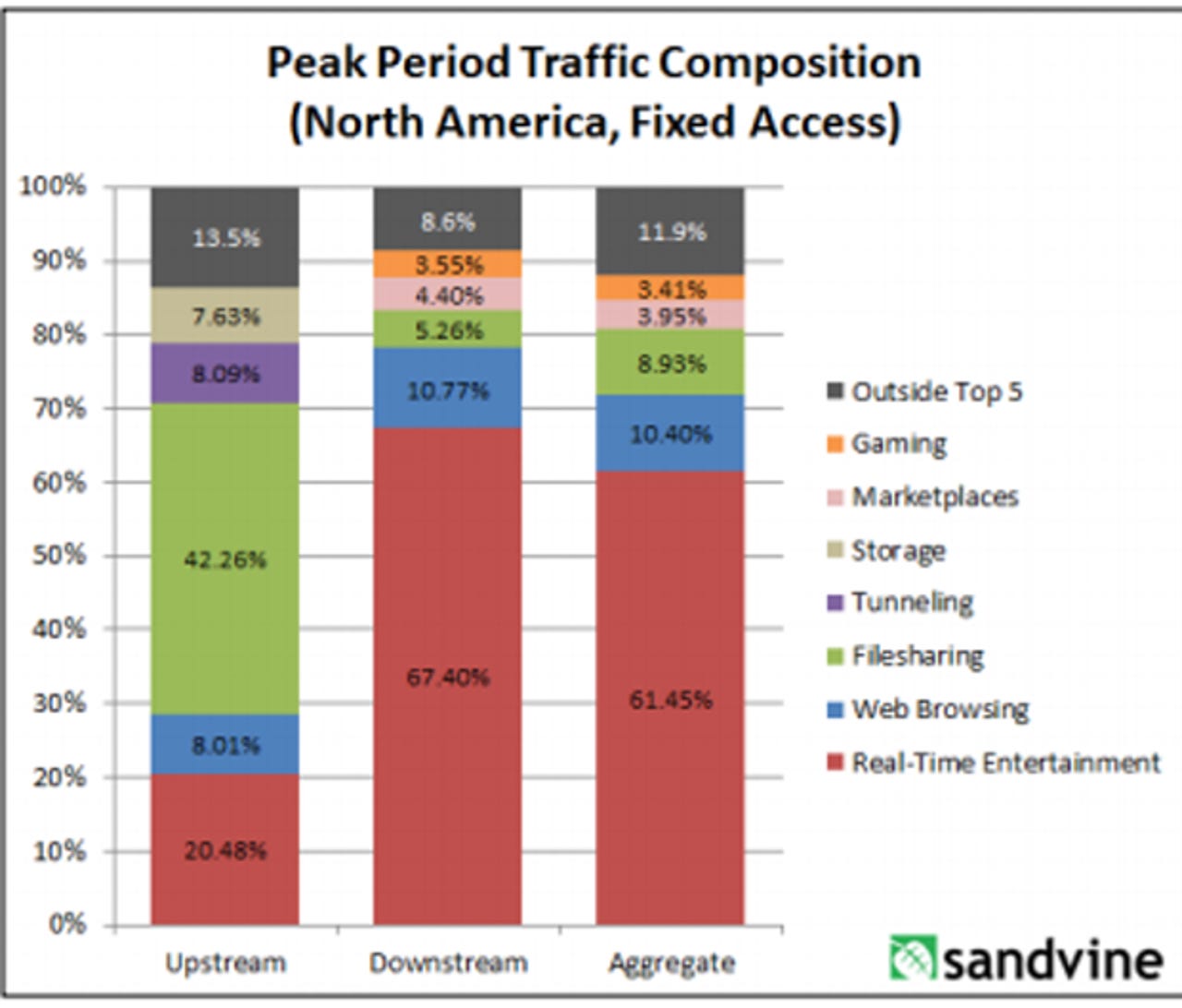The Internet belongs to YouTube and Netflix

Today's question: Which purpose do we use the Internet the most for: 1) file-sharing; 2) playing games; 3) work, or 4) watching TV and movies? The answer is—Ding! Ding!--watching TV and movies. Lots and lots of them!

How many videos? Enough that in its latest analysis of Internet traffic, Sandvine found "real-time entertainment (comprised of streaming video and audio) continues to be the largest traffic category on virtually every network we examined, and we expect its continued growth to lead to the emergence of longer form video on mobile networks globally in to 2014."
Specifically, "In North America, the dominance of real-time entertainment is due in large part to the continued market leadership of Netflix and YouTube, which account for over half of the downstream traffic during peak periods. In other regions, YouTube continues to be the largest single source of real-time entertainment traffic on both fixed and mobile access networks, which makes it the leading source of Internet traffic in the entire world."
In the United States, Netflix rules. It has 31.62 percent of all downstream traffic during peak hours. YouTube followed with 18.69 percent, then HTTP, the Web protocol, with 9.74 percent. The file-sharing protocol BitTorrent took fourth with 4.05 percent and iTunes won fifth place with 3.27 percent. The other video-streaming sites such as Amazon Instant Video and Hulu take the 8th and 10th spots with 1.61 percent and 1.29 percent respectively.
As Sandvine states, "Netflix continues to be the unchallenged leader for traffic, ...While we observed that their share of traffic decreased slightly since our 1H 2013 study, it should not be interpreted as a decline in the dominance of the service at the expense of their competitors. In fact, the bulk of data collection for this report occurred before Netflix made SuperHD content available to all subscribers, regardless of the service provider. Based on initial findings from customers, we expect Netflix's share to return to or even surpass its previous heights."
YouTube is growing much faster than Netflix though. It's almost doubled its traffic since the first half of 2013.
File-sharing, which one dominated Internet traffic continues its decline. "BitTorrent continues to lose share and now accounts for just 7.4 percent of traffic during peak period and Filesharing as a whole now accounts for less than 10 percent of total daily traffic. This demonstrates a sharp decline in share. Long are the days when file-sharing accounted for over 31 percent total daily traffic, as we had revealed in our 2008 report."
Mobile network traffic, where Internet costs tend to be higher, is also dominated by real-time entertainment. Here, however, it's a far broader mix of services that makes up the top traffic-generators. In the world of 3G and 4G networking, YouTube is number one with 17.69 percent, with Facebook in second place with 15.44 percent, and HTTP is in third with 14.07 percent. Curiously, MPEG Internet traffic, which is used by many video sites, takes fourth and Secure-Socket Layer (SSL) lands in fifth with 7.84 percent.
Netflix comes in at only 8th with 5.01 percent. That could be because people are willing to watch movies and TV shows on their PCs or stream to their TV with Roku boxes, they're not so happy about watching The Avengers on a 4-inch smartphone screen. That said, with the rise of tablets, Netflix use is rising on mobile networks as well. Sandvine found "Netflix’s downstream traffic share in North America almost doubled from 2.2 percent to 5.0 percent in just 18 months time."
With all this video traffic, Internet quality can sometimes suffer. If your video starts stuttering don't be too quick to blame the rise of overall traffic or your ISP. Sandvine also found that the popular Speedtest.net can often give contradictory results. Sandvine discovered that the load on a Speedtest server and the route your traffic takes to that server can greatly influence your results.
In addition, Sandvine found that YouTube's video quality typically goes downhill twice a day. Once, when you would expect, at the height of the evening peak period when the networks are most congested and then during the lunch hour. Sandvine believes that the problem isn't in slow, rush-hour Internet traffic but that Google's YouTube server farms simply aren't able to meet the high video demand. If you want to check on yourself the next time you have problems head to the YouTube Video Speed History page and its Test Video.
Related Stories:
- Akamai: Malicious Internet traffic shifting borders
- Google quietly hit a major milestone for North American Internet traffic
- Cisco: Mobile Internet data traffic to grow 13-fold by 2017
- Deutsche Telekom to foreign secret services: 'Eyes off our internet!'
- Cisco projects data center-cloud traffic to triple by 2017